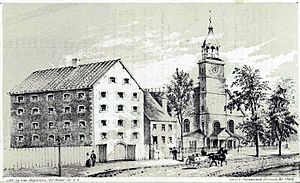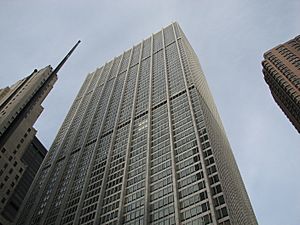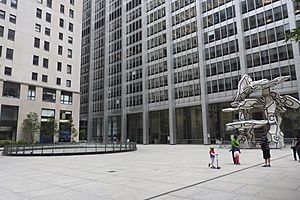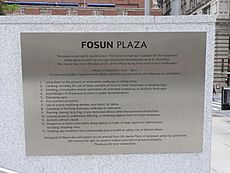28 Liberty Street facts for kids
Quick facts for kids 28 Liberty Street |
|
|---|---|
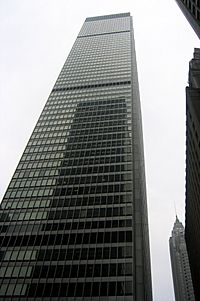
The western facade viewed from the ground
|
|
| General information | |
| Status | Complete |
| Architectural style | International |
| Location | 28 Liberty Street New York City 10005 United States |
| Coordinates | 40°42′28″N 74°00′32″W / 40.70778°N 74.00889°W |
| Construction started | January 1957 |
| Topped-out | September 1959 |
| Completed |
|
| Owner | Fosun International |
| Height | |
| Architectural | 813 ft (248 m) |
| Technical details | |
| Floor count | 60 (+6 below grade) |
| Floor area | 2,299,979 sq ft (213,675.0 m2) |
| Lifts/elevators | 37 |
| Design and construction | |
| Architect | Skidmore, Owings and Merrill |
| Structural engineer | Skidmore, Owings and Merrill, Weiskopf & Pickworth LLP |
| Main contractor | Turner Construction |
|
New York City Landmark
|
|
| Designated | February 10, 2009 |
| Reference no. | 2294 |
28 Liberty Street, formerly known as One Chase Manhattan Plaza, is a 60-story International style skyscraper in the Financial District of Manhattan in New York City, between Nassau, Liberty, William, and Pine Streets. The building was designed by Gordon Bunshaft, of the firm Skidmore, Owings & Merrill (SOM), and consists of a stainless steel facade with black spandrels below the windows. Opened in 1961, it is 813 feet (248 m) tall.
28 Liberty Street, on the northern half of a 2.5-acre (1.0 ha) site, consists of 60 above-ground stories, a ground-level concourse, and five basement levels. A plaza that surrounds the tower includes a sunken Japanese rock garden designed by Isamu Noguchi. The building's design is similar to that of SOM's earlier Inland Steel Building in Chicago.
David Rockefeller, Chase's executive vice president, proposed the tower in the 1950s as a means to keep the newly merged Chase Manhattan Bank within Lower Manhattan while merging its 8,700 employees into one facility. Construction started in early 1957, and though the tower opened in early 1961, the basements and plaza were not opened until 1964. Despite some early challenges, One Chase Manhattan Plaza was nearly fully occupied from its opening, with numerous financial and legal tenants. The building was renovated in the early 1990s, and Chase moved its headquarters in 1997. The New York City Landmarks Preservation Commission designated the building a landmark in 2008. Chase Manhattan's parent company JPMorgan Chase sold the building to Chinese investment company Fosun in 2013; the building was subsequently renamed 28 Liberty Street.
Contents
Site
28 Liberty Street is on the northern half of a city block bounded to the west by Nassau Street, to the north by Liberty Street, to the east by William Street, and to the south by Pine Street. Its plaza is on the southeastern portion of the site, while the southwestern portion is occupied by 20 Pine Street, which had been Chase Manhattan Bank's previous headquarters. The tower and the plaza cover 2.5 acres (1.0 ha) in total. The site slopes down to the north, so that the plaza is at the elevation of Pine Street, while Liberty Street is one story beneath the plaza; there are an additional five basements under the plaza. There are stairs leading down the east side of the plaza to Cedar Street.
Within 28 Liberty Street's immediate surroundings are the Federal Reserve Bank of New York Building to the north; the Chamber of Commerce Building and Liberty Tower to the northwest; 140 Broadway to the west; and the Equitable Building to the southwest. The public plaza faces Federal Hall National Memorial to the southwest and 40 Wall Street to the south. The building's concourse has a direct entrance to the Wall Street station (2 and 3 train) of the New York City Subway. There are also connections to Wall Street (4 and 5 train) and to Broad Street (J and Z train) via passageways underground.
Previous uses
The block was formerly two smaller city blocks, separated by Cedar Street, which ran from west to east. The Middle Collegiate Church was built on the northern portion of the lot in 1731. Later becoming the city's main Post Office in the mid-19th century, the church building was torn down in 1882. The building site then served as the headquarters of the Mutual Life Insurance Company of New York from 1884 until the company moved to Broadway in 1950. Mutual Life had expanded into several annexes on Liberty and Cedar Streets, as well as rented space in two buildings on Cedar Street.
Cedar Street was closed in the late 1950s to make way for 28 Liberty Street's construction. In exchange for acquiring the block of Cedar Street, Chase agreed to cede 8 to 15 feet (2.4 to 4.6 m) on each side of the lot for street-widening; paid the city $100,000; and took responsibility for utilities under the newly closed portion of Cedar Street. The city had rarely closed streets for private commercial development, except when there was "substantial" benefit to the public, such as with Grand Central Depot (later Grand Central Terminal) and the original Pennsylvania Station. Chemical Bank, which purchased the adjacent 20 Pine Street, agreed to carve out an arcade on that building along the southern facade of the ground level in order to allow the widening of the Pine Street sidewalk.
Design
Skidmore, Owings & Merrill (SOM) designed 28 Liberty Street. Four of the firm's thirteen general partners were most involved with 28 Liberty Street's design, namely Gordon Bunshaft, Edward Mathews, Nathaniel A. Owings, and J. Walter Severinghaus. Bunshaft, who was tasked with the building's general design, passed most of the planning responsibilities to Roy O. Allen and Jacques E. Guiton, since Bunshaft was also involved in several other projects at the time. Three contractors were hired to excavate the foundations, while Turner Construction was hired as the general contractor. Weiskopf & Pickworth was hired as the structural engineer.
The building comprises a 60-story tower atop a base composed of five basement stories and the ground floor on Liberty Street. It has a total height of 813 feet (248 m), making it the third-tallest building in the Financial District upon its completion, after the 927-foot (283 m) 40 Wall Street and the 950-foot (290 m) 70 Pine Street. In addition, 28 Liberty Street was the first curtain-walled building to be taller than 800 feet (240 m).
Form
The 1916 Zoning Resolution, which required skyscrapers in New York City to have setbacks as they rose, was designed to prevent new skyscrapers from overwhelming the streets with their sheer bulk. However, these setbacks were not required if the building occupied 25% or less of its lot. As a result, 28 Liberty Street was designed as a single slab. While buildings with setbacks had less office space on upper floors, Chase wanted to make the upper floors as desirable to tenants as the lower floors, which led to each floor having the same area. Chase was granted a variance from the New York City Board of Standards and Appeals so that the building actually occupied 27.3% of the site; the extra 2.3% site coverage allowed for an additional 700 square feet (65 m2) on each 29,680-square-foot (2,757 m2) floor.
Facade
The facade is composed of 8,800 plate glass panes, each measuring 8 feet (2.4 m) tall by 5 feet (1.5 m) wide. The glass panes are set within aluminum panels—chosen for their durability and performance—as well as vertical aluminum mullions. The aluminum panels were 0.25 inches (6.4 mm) thick by up to 13 feet (4.0 m) tall and were manufactured by the General Bronze Corporation. The spandrel panels between the windows on each story were made of natural-color aluminum or black porcelain enamel.
The building's forty columns, sheathed with aluminum, are about 3 by 5 feet (0.91 by 1.52 m) thick and are about 29 feet (8.8 m) apart from each other, arranged in a 4×10 grid. The columns extend from the building on its long sides, while floors cantilever on the columns on the building's short sides; together, the columns carry much of the weight of each floor. The New York Times described this as a relatively novel design, which had never been used on such a large scale. The presence of the columns at ground level creates a colonnade around the lobby, which is recessed behind the upper floors. The columns are above steel assemblies some 100 feet (30 m) below ground level; these assemblies are 12 feet (3.7 m) square and 7 feet (2.1 m) thick. In total, over 53,000 short tons (47,000 long tons; 48,000 t) of steel were used in 28 Liberty Street; at its completion, it had more steel than any other New York City skyscraper except the Empire State Building and 30 Rockefeller Plaza.
The 11th, 31st, and 51st floors and the third basement level are mechanical floors. Each of the above-ground mechanical floors is a double-height space, with regular windows along the facade on the upper half of each floor, and ventilation grates on the lower half.
Features
Interior spaces
The building has about 1.8 million square feet (170,000 m2) of above-ground floor area. Each story measures 280 by 106 feet (85 by 32 m), with about 30,000 square feet (2,800 m2) of area. This made 28 Liberty Street the largest new building in New York City by floor area since the mid-1930s. The interior columns were hidden inside the building's "core", which contained its elevators and service rooms. This provided great flexibility for the interior floor plans, which many prospective tenants desired. The floor plan was slightly asymmetrical, as the southern side was ten feet wider than the northern side, with columns spaced 40 feet (12 m) apart from north-to-south. There were only 150 private offices for the 7,500 employees who worked in the tower upon its opening. The offices of Chase's three highest-ranking executives were on the 17th floor. Bunshaft had planned to place a sculpture on the 60th-story landing, but after realizing that the ornamented spire of 40 Wall Street was visible from that level, abandoned plans for the sculpture.
The 30-foot-tall (9.1 m) lobby, at the same level as the raised plaza, had a footprint slightly smaller than the floors above it, and was surrounded by a plate-glass wall. There are numerous revolving doors to the south and west. Originally, there was a mezzanine for the loan offices, which was removed by the 1990s. Inside the lobby are six elevator banks, surrounded by travertine walls. The concourse, directly below the lobby, was accessed from Liberty Street. Chase's main branch, beneath 28 Liberty Street's plaza, was accessed from the concourse and was lit by a oval 60-foot-diameter (18 m) recess surrounded by a transparent barrier. Also on the concourse was a meeting room, a foyer, and a messenger's room. Passageways in the concourse led to the three surrounding subway stations.
The floors beneath the plaza are much larger, covering the entire lot with a combined area of 600,000 square feet (56,000 m2). There are five basement levels below the concourse, which include a truck ramp going to the second basement; dining and kitchen space on the first and second basements; printing, tabulating, and mechanical spaces on the third basement; check handling on the fourth basement; and vaults on the fifth basement. The truck entrance, as well as ventilation grates for air intake and outflow, are on the Liberty Street side, below the raised plaza. There is also a pedestrian entrance on the William Street side, below the plaza, which leads to the eastern part of the concourse. According to Architectural Forum, the fifth basement had a "bank vault nearly the size of a football field", which sorted $35 billion worth of securities (equivalent to $246.3 billion in 2021).
Mechanical systems and elevators
Escalators connected the lobby to the concourse directly below it. There are 43 elevators in total: three service elevators running from the basements to the lobby; six passenger elevators from the lobby to the basements; and thirty-four passenger elevators from the lobby to the upper floors. The upper-floor elevators ran nonstop from the lobby to serve the upper floors, and were arranged in five "banks": one elevator bank served the second through 17th floors; three banks each served ten stories between the 17th through 47th floors; and the fifth bank served the 47th through 60th floors.
Air-conditioning units on each mechanical floor weighed a total of 9,200 short tons (8,200 long tons; 8,300 t), making it "the largest fully air-conditioned building in New York". There are refrigeration units and steam turbine compressors on the 11th and 31st floors; the equipment on the 11th floor serves all stories below the 21st, while the equipment on the 31st floor serves all stories above the 22nd. An air-conditioning system is embedded in the ceiling of each story. The building was powered by transformer vaults in the first basement and the 51st floor, which in turn drew their power from primary feeders on the second basement. On the roof are a series of fans, which are hidden behind a four-story enclosure with a surrounding parapet.
Plaza
The plaza, officially known as the David Rockefeller Plaza since 2008, is slightly raised above the surrounding streets, with a surrounding parapet, and surrounds the tower. Due to the topography of the area, the northern end of the plaza is 20 feet (6.1 m) above ground level, while the southern end is just above ground level. The plaza was unusual in that it was in a locale with extremely high land values "where land was worth up to $10 million an acre [$25 million per hectare]". Legally, the plaza is private property rather than a privately owned public space. Three marble staircases and two ramps connected the sidewalk to the plaza: a wide staircase and ramp from Pine Street to the south, a split staircase and ramp from Nassau and Cedar Streets to the west, and a smaller staircase from William and Cedar Streets to the east. Other features of the plaza include planteres and benches.
Sculptor Isamu Noguchi, a frequent collaborator of Bunshaft's, was consulted for the design of the plaza. Original plans in 1956 called for square or rectangular recesses in the plaza, accessed by a spiral staircase, but the final 1957 design called for a circular recess, accessed from the concourse. Noguchi created a sunken Japanese rock garden in the recess, similar to one at Yale University's Beinecke Rare Book & Manuscript Library, as part of a series of contemporary artworks collected or commissioned by Chase Manhattan. Seven large, dark basalt rocks from Japan were used in the garden, placed atop a surface of 27,000 white granite blocks, each measuring 4 inches (100 mm) square. Additionally, the garden incorporated three fountains fed by 45 pipes, which drained into a trough that circumscribed the rock garden. Originally, the rock garden had a pool with goldfish, but the goldfish were removed in 1964, having died of copper poisoning when people threw pennies into the pool.
In 1970, Chase commissioned a monumental sculpture entitled "Group of Four Trees" by French artist Jean Dubuffet, and two years later, it was installed in the building's plaza. The sculpture is made of several fiberglass "leaves" and painted with polyurethane in hues of black and white. At the time, the 40-foot (12 m)-tall sculpture was the largest outdoor public artwork in New York City, beating out Pablo Picasso's "Bust of Sylvette" by 4 feet (1.2 m).
History
Two established banks in Lower Manhattan, the Chase National Bank and the Manhattan Company, merged to create the Chase Manhattan Bank in 1955. Chase had been the largest bank in the U.S. until the early 20th century, and the merger made the Chase Manhattan Bank the second-largest bank in the United States. The combined company was at 20 Pine Street. At the time, the Financial District had languished after many corporations had moved uptown. Few large buildings and structures had been erected in the neighborhood since the 1930s, except for transit infrastructure such as the Brooklyn–Battery Tunnel and office towers at 99 Church Street and 161 William Street.
Planning and construction
Initial planning
In January 1955, Chase Manhattan president John J. McCloy hired David Rockefeller, patriarch of the Rockefeller family, as the company's executive vice president for redevelopment. Rockefeller later recalled that he had persuaded McCloy to employ a "qualified outside firm" to conduct studies on what facilities Chase Manhattan needed. The firm, Ebasco Services Incorporated, conducted numerous studies and determined that the company should buy land for a single headquarters at one of two possible locations: the "Broad Street block" and the "Mutual Life block". The firm further recommended a "definitive and dramatic" design. Rockefeller worked closely with real estate developer William Zeckendorf, who suggested purchasing the Mutual Life block between Nassau, Liberty, William, and Pine streets. In February 1955, the Chase Manhattan Bank purchased the Mutual Life plot for $4.425 million to construct a new headquarters called One Chase Manhattan Plaza. While Chase Manhattan claimed at the time that it had no plans to construct new headquarters, demolition began in May 1955.
SOM was hired for the project in early 1955. Accounts vary on how SOM was selected: Rockefeller wrote that the firm had been recommended by his friend, the architect Wallace Harrison, though Owings claimed that the firm had sought the commission of their own volition. SOM considered three plans for the site: a single building on the block between Cedar and Liberty Streets; two buildings spread out across the two blocks between Pine and Liberty Streets; and a single building on the two blocks, with a plaza abutting it. Although The New York Times later said that Owings "claimed credit for the idea of placing a skyscraper on a small part of a downtown lot", Rockefeller stated that Zeckendorf was the person responsible for the tower-and-plaza scheme. In September 1955, Guiton presented at least two of these plans to Chase's board of directors. While the tower-and-plaza plan had marginally less interior space than two separate buildings, it was the proposal ultimately selected.
Finalization of plans
The Chase Manhattan Bank officially publicized their intentions to rebuild the two-block site in November 1955; the planned development was described as part of a new "Rockefeller Center" for Lower Manhattan. The following month, further details of the redevelopment were revealed, including a wider-ranging redevelopment of the Financial District. In addition to the new Chase tower, the plan included a 750-unit middle-income housing project on Whitehall Street, a 1,000-spot parking garage on Pearl Street, and a $6.19 million widening of Water Street, promoted by Rockefeller's Downtown–Lower Manhattan Association. The wider redevelopment was conceived in conjunction with city planner Robert Moses, mayor Robert F. Wagner Jr., and Manhattan borough president Hulan Jack. In particular, Rockefeller said that Moses's approval of the project preceded approvals from other entities.
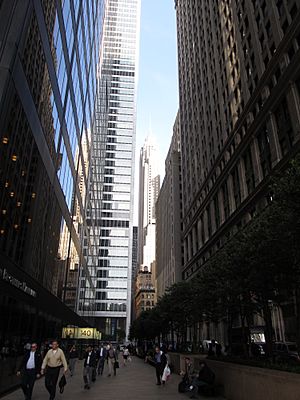
SOM's design, influenced by the firm's Seagram Building and Inland Steel Building, was completed in early 1956, and SOM submitted blueprints to the New York City Department of Buildings that February. At that point, The New York Times predicted the project would cost $75 million, which included the plaza's cost. The bank's board approved $75 million in March 1956 for the construction of the new tower along with a large public plaza. The bank planned to occupy 1 million square feet (93,000 m2) of the building and lease the remaining 700,000 square feet (65,000 m2) to outside tenants. Guiton said that the bank's board applauded the plans when they were approved. Shortly after, the plans were unveiled to the public.
Construction
Construction on the tower began in late 1956. Before starting work on One Chase Manhattan Plaza, SOM built a one-story mockup with aluminum and stainless steel at Roosevelt Field. Of these, aluminum was used for its cost and appearance, despite both materials performing similarly. A groundbreaking ceremony for the building was held on January 29, 1957, with the first ceremonial scoop of dirt being excavated by Chase Manhattan's longest-tenured worker. At the time, the total cost was estimated at $121 million, with $94 million for construction, another $16 million for utilities and land acquisition, and $11 million for furniture.
Up to 1,800 workers were employed at any given time. Foundation work took place between March 1957 and November 1958, and excavations reached 90 feet (27 m) below ground level. The first of the steel assemblies, upon which each of the 40 structural-steel columns would be placed, was installed within the foundation in September 1958. Afterward, steel work commenced in December 1958, with the building topping out during September 1959. This was followed by the completion of the curtain wall in March 1960.
Completion was initially anticipated for 1959, but four citywide strikes of construction workers, including an 18-week elevator worker strike, delayed construction. Furthermore, a crane operator died in a June 1958 construction accident. By December 1960, the tower was completed, and Chase Manhattan Bank employees began moving in to the new tower the next month. Chase Manhattan opened a temporary office within the tower while the plaza and basements were under construction. The official opening was held on May 28, 1961; the southern block had not been cleared at the time of the tower's opening, and the only progress on that block was a group of nine trees that had been planted on Nassau Street. The plaza was completed in December 1963, and the permanent banking office underneath it opened the next month, after which the temporary office was turned into an auditorium. The plaza's official opening was celebrated with a party in May 1964. The structure cost $138 million in total, including the plaza.
Chase Bank ownership
Late 20th century
From the beginning, One Chase Manhattan Plaza had a 99% occupancy rate: the bank was on the lower stories, and 61 companies with a combined 2,500 workers were on the upper stories. The tenants were mainly financial tenants such as EF Hutton and Fuji Bank; law firms like Cravath, Swaine & Moore; and a private luncheon club called the Wall Street Club. The building's address caused problems for mail delivery persons and the general public. By the early 1970s, though the names of several other buildings in Manhattan ended in the word "Plaza", One Chase Manhattan Plaza was the only such building that did not have an address designation based on a surrounding street. The "Group of Four Trees" sculpture in the plaza was installed in 1972.
In its early years, the building faced several challenges. The glass panels began blowing away from the building during high winds: during 1962, fifteen glass panels fell from the building due to negative pressure caused by combination of the building's design and minute weaknesses in the glass. All of the building's 8,800 panels were reinspected, with similarly weakened panels replaced. A fire also took place in the sub-basement in 1962, and an anti-Vietnam War bombing occurred on the 16th floor in 1969, causing minor damage. A Brink's truck in the building's underground garage was robbed in 1979 by two armed men driving a stolen fish truck, who took two hostages before transferring over $2 million into the refrigerated truck. The truck was later found abandoned, and the robbers escaped.
In 1990, law firm Milbank, Tweed, Hadley & McCloy signed a lease for 330,000 square feet (31,000 m2) of space in the tower with options to expand to up to 750,000 square feet (70,000 m2). The next year, Chase embarked on a comprehensive renovation of the building, the first major overhaul since its opening 30 years earlier; the renovations were undertaken by SOM. The bank spent $30 million to clean the building's exterior, upgrade elevators, remove asbestos, remodel the lobby, remove the mezzanine, and improve the heating and cooling systems. At the time, numerous large tenants had moved out or were in the process of doing so: law firm Cravath, Swaine & Moore had relocated elsewhere in 1990, and Davis Polk & Wardwell moved to 450 Lexington Avenue the next year. The renovations were completed by 1994. While Chase moved its headquarters to 270 Park Avenue in 1996, it retained 70% of the space at One Chase Manhattan Plaza.
21st century
By March 2008, the tower and the surrounding plaza were being considered for official landmark status. The same month, the public plaza around the tower was renamed for David Rockefeller. The New York City Landmarks Preservation Commission held hearings to designate One Chase Manhattan Plaza as an official landmark in mid-2008, and officially recognized the building as such on February 10, 2009.
Chase placed a temporary barricade fence around the plaza in September 2011, at the same time the Occupy Wall Street protests were occurring nearby, though Chase did not specify an exact reason. The ostensible reason for the barricades was construction work in the plaza, though observers saw little work within the plaza, leading to numerous lawsuits against the city's Department of Buildings and Chase; one such lawsuit alleged that the barriers violated the right to freedom of speech provided under the First Amendment to the United States Constitution, although the plaza was a private space. Some advocates lodged complaints with the Landmarks Commission, though the barricades were not under the commission's jurisdiction since they were movable barriers. The barricades were dismantled in November 2013.
Fosun ownership
In 2013, Steve Witkoff made an unsolicited $650 million offer to purchase the building and convert it into a hotel and condominiums. While JPMorgan rejected the offer, it prompted the firm to begin marketing the building to potential bidders as both an office building or a residential conversion opportunity. The building was placed for sale in August 2013. The auction reportedly initially attracted about a dozen bidders, including Witkoff, Harry Macklowe, Joseph Chetrit, Tishman Speyer, Boston Properties, Starwood Capital Group, RXR Realty, and at least two wealthy Asian investment funds.
On October 18, 2013, JPMorgan sold the building to Fosun, a Chinese investment company, for $725 million, finalizing the sale that December. Fosun rebranded One Chase Manhattan Plaza as 28 Liberty Street in 2015. The new name refers to the building's position on Liberty Street, but also connects to the Statue of Liberty in the distance and to "the good fortune that, according to Chinese tradition, is bound up in the number 8 [and] 28 denotes 'double prosperity'". Fosun invested $150 million into reconfiguring the building's ground and lower floors into a 200,000 square feet (19,000 m2) retail complex. The renovations included a 35,000 square feet (3,300 m2) food hall on the ground floor as well as a 45,000 square feet (4,200 m2), 10-screen Alamo Drafthouse Cinema in the below-ground space. To fund the improvements, Fosun secured an $800 million loan from Deutsche Bank and HSBC in November 2017.
In 2018, Danny Meyer opened "Manhatta", a restaurant and event space taking up the building's entire 60th floor. The same year, Milbank, Tweed, Hadley & McCloy left their 340,000 square feet (32,000 m2) space in the building for the newly built 55 Hudson Yards.
Tenants
- Allianz Global Corporate & Specialty
- Assurant
- Attorney General of New York
- Booking.com
- HelloFresh
- Ironshore
- JLL
- JPMorgan Chase
- Local Initiatives Support Corporation
- London Stock Exchange Group
- MSCI
- Serendipity Labs
- Wolters Kluwer
See also
 In Spanish: 28 Liberty Street para niños
In Spanish: 28 Liberty Street para niños


